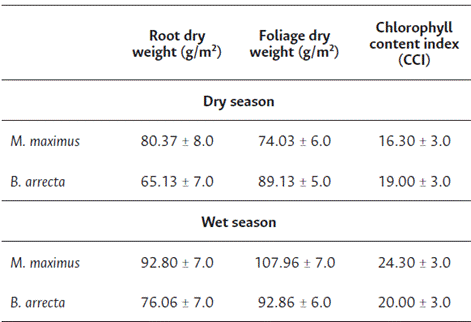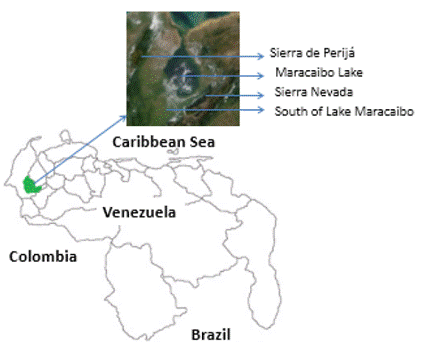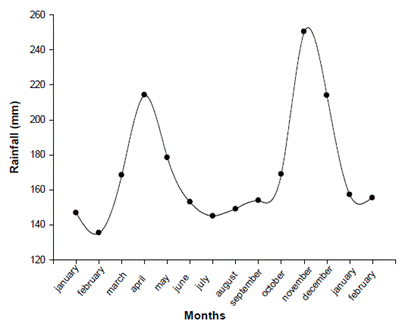Introduction
The use of mixed pastures in the Venezuelan humid tropics can be a good strategy when it comes to livestock feeding. Ferri et al. (2015) define it as a pasture made up of two species (simple mixture) or three or more species (complex mixture); in both cases, the species may or may not be of the same cycle or genus, further pointing out that their integration into the agroecosystems is beneficial both for animals and the environment.
For many agricultural producers in the South of Lake Maracaibo, Venezuela, when several grasses are associated, only one of them is the crop and the rest is weed since they compete for light, nutrients and space, noting that monoculture provides the possibility of adequately managing grazing because palatability, digestibility and yield are better controlled.
On the other hand, for many researchers, mixed pastures are presented as good indicators of biodiversity and sustainability, which can meet the environmental challenges that we currently face (Fraser and Rosa-García, 2018; Motta-Delgado et al., 2019). Similarly, associated pastures can respond favorably to the critical time and animal load (Woodward et al., 2013).
In this work, the ecophysiological response of two associated grasses, Megathyrsus maximus (Jacq.)B. K. Simon & Jacobs and Brachiaria arrecta (T. Durand & Schinz) Stent was studied during the wet and dry season in conditions of the Humid Tropics of Venezuela, to determine if this association benefits these species and highlight their use.
To meet the objective set, root and foliage dry weight were determined in the different pastures and in every season, since this parameter is a measure of the performance of the carbon fixation process and the conversion of light energy into biomass (Del Pozo, 2002). In addition, the chlorophyll content index (CCI) was measured as an indicator of the level of stress, since this variable is very sensitive to biotic and abiotic stressors (Opti-Sciences, 2018).
Materials and methods
Study area
The South of Lake Maracaibo, in Venezuela, corresponds to an ecosystem of megadiverse macrothermal humid forest, which was originally covered by lush vegetation, with endemic floristic elements of the Amazonas and Venezuelan Guayana (Aymard, 2011). Today, the original landscape has been transformed by the phenomenon of cattle ranching, constituting one of the geographic areas with the highest agricultural production in Venezuela.
The study was carried out in a bovine production unit dedicated to the commercial exploitation of dual-purpose dairy cattle, located at 8°25’30’’N and 71°36’01’’W over 54 m.a.s.l., in the municipality of Alberto Adriani, state of Mérida, Venezuela, from January 2019 to January 2020 to include the dry and wet season (Figure 1). This area has associated pastures of M. maximus and B. arrecta, with no fertilization, traditional management of semi- intensive livestock farms with modulated rotational grazing system, handling a load of 1.5 animal units (AU) per hectare per year, one day of occupation, and 28 days off.
For the year of study, an average temperature of 34 °C and 78 % of relative humidity was recorded through a Celestron Weather Station. Rainfall distribution was determined using an analog Autana rain gauge, evidencing the existence of a bimodal model (Figure 2) with two peaks of rainfall, one in April and the other in November. Both devices were installed in the workplace.
Vegetal matter
The pastures studied had a floristic composition dominated by the perennial grasses of forage interest Megathyrsus maximus and Brachiaria arrecta, both originating from tropical Africa, with C4 photosynthesis (Del Pozo, 2002). The first was described by Hernández and García-Trujillo (1978) as a plant with a tiller growth habit with tillers up to 30 cm long, sheathed leaves, with a length between 25 cm and 80 cm being these long and sharp. It can produce 10 - 30 Tm/ha/year of dry matter (DM) and reach a crude protein level of 10 % - 13.5 % and a percentage of digestibility of 55 % - 65 %. The second grass is described by Oliveira et al. (2006) like a rising grass with strong roots, stoloniferous with 36 to 150 cm in length, and an indeterminate number of internodes. It can produce 25 - 30 Tm/ha/year of DM and reach a crude protein level of 8 % - 12 % with a digestibility percentage of 55 % - 60 %.
Determination of dry matter
Two samplings were carried out per season. For this, a forage identification protocol proposed by Valles (2016) was used, which consisted of randomly using a 90 cm2 metal frame following a zigzag route in seven paddocks, all with 28 days off, taking three subsamples in each one. To take the foliage samples, all grass found inside the frame was cut at a height of 5 cm from the ground, except for the root samples, which were extracted by chopping the ground with the help of a pickaxe. The samples were placed in properly labeled paper bags to be transferred to the laboratory.
In the laboratory, the foliage and root samples were placed in an oven at 60 °C for 72 hours or until a constant weight was achieved. Subsequently, it was weighed on an analytical balance and the DM value was recorded.
Chlorophyll content index (CCI)
In the countryside, the plants used for the determination of dry weight were subjected to a CCI measurement in the morning to reduce the effect of chloroplast movement in response to high radiation, as this factor may alter the measurements (Rangel and Uzcátegui, 2018).
A CCM-200 Opti-Sciences chlorophyll content meter was used. This device works based on the optical properties of the leaf, namely the reflectance and transmittance of the light emitted by the sensor. The CCI refers to the absorption of chlorophyll present in the tissue (Carter and Knapp, 2001; Dong et al., 2019).
This device employs two wavelengths, one at a chlorophyll absorption range of 653 nm and another at 931 nm, that serve to compensate differences due to tissue thickness, calculating the CCI as percentages (Dong et al., 2019).
The method consisted of placing the foliar tissue of grass with a size at least of 0.95 cm2 in the measurement chamber, while the CCI value was visible on the device. For this purpose, the measurement of the second leaf was taken at the midpoint of the blade after the flag leaf, as this leaf is considered as a sign of full maturity (Rangel and Uzcátegui, 2018; Sánchez-Hernández et al., 2019).
Statistical analysis
The obtained data were processed by the statistical package RStudio for Windows. As a first step, the Shapiro-Wilks test was performed to test the normality of the data. Subsequently, the comparative analysis of the means for each variable between the wet and dry seasons was carried out by the U-Mann Whitney test.
Results
Root dry weight
Regarding the root dry weight performance in M. maximus, average values of 80.37±8 g/m2 and 92.80±7 g/m2 were recorded in the dry and wet season, respectively (Table 1), without finding any statistically significant difference between them (p>0.05). For B. arrecta, 65.13±6 g/m2 was measured in the dry season and 78.06±6 g/m2 in the wet season (Table 1); as for M. maximus, no significant differences were found (p>0.05) for this variable between the two seasons.
Foliage dry weight
Regarding the foliage dry weight of M. maximus, an average of 74.03±6 g/m2 was recorded for the dry season and 107.96±7 g/m2 for the wet season (Table 1), these results showing that there is a significant difference (p<0.05) between the two seasons. On the other hand, for B. arrecta, 89.13±5 g/m2 was measured in the dry season and 92.86±6 g/m2 in the wet season (Table 1), without these values indicating significant differences (p>0.05) in this variable for this species.
Table 1 Root dry weight, foliage dry weight and chlorophyll content index of M. maximus and B. arrecta during the dry and wet season

Mean ± standard error.
Chlorophyll content index
In relation to the Chlorophyll content index, in M. maximus, average values of 16.30±3 CCI and 24.80±3 CCI were recorded in the dry and wet season, respectively (Table 1), these values being different between the two seasons (p<0.05). On the other hand, B. arrecta presented values of 19.00±3 CCI and 20.00±3 CCI in the dry and wet season, respectively (Table 1), without this presenting any significant difference (p>0.05) for this variable in this species between the two seasons.
Discussion
In this work, root dry weight and foliage dry weight were measured as indicators of carbon fixation and the conversion of light energy into biomass for two associated species in a mixed pasture, across the two seasons of the year, to determine if this association influences these parameters.
Regarding root dry weight, no significant differences were found between the two seasons for the two species. These results are consistent with some researchers such as Abril et al. (2017), who reported similar production of root dry matter in M. maximus under favorable conditions of field capacity in controlled environments and plants under water stress inoculated with Bacillus sp. However, it contradicts Baruch et al. (1989), who indicate that the species Trachypogon plumosus has a higher underground/aboveground biomass index in the dry season because more photoassimilates are invested in root production since water availability is a limiting factor for its growth and development; at the same time, a wider root allows it to cover a larger area of soil to supply water. However, our results may be due to the fact that during the year of fieldwork, the dry season was not pronounced (Figure 2), a characteristic very typical of the humid tropics, such as the region south of Lake Maracaibo (Aymard, 2011).
Regarding the dry weight of the foliage, for B. arrecta, there were no significant differences between the two seasons, whereas for M. maximus, differences were observed, being the dry weight greater during the wet season. Similar results have been reported for M. maximus by Verdecia et al. (2008), Shintate et al. (2017), and Polo (2021). This difference is mainly due to the fact that the wet season is always the most favorable for plant growth. April et al. (2019) show the highest production of aerial biomass under favorable conditions of field capacity in controlled environments in M maximus.
In this study, both grasses were expected to have higher foliar dry weights in the wet season, but this premise was fulfilled only for M. maximus, and not for B. arrecta. Baruch et al. (1989) indicate that this type of response in African grasses introduced, as B. arrecta, is possible under optimal water supply conditions.
Regarding the foliar dry weight, it is possible to infer that B. arrecta is a stoloniferous grass of smaller size than M. maximus, which is tillering and taller. When these two species constitute an associated pasture, B. arrecta is found under the shadow of M. maximus, which results in lower transpiration rates due to the fact that it receives less direct radiation, less water stress, higher photosynthetic rates and therefore greater carbon fixation.
In this study, the CCI was assessed as an indicator of stress in pastures, which helps to determine if the association of the grasses influences this parameter. The results obtained indicate that the species M. maximus is stressed during the dry season, possibly due to some factor such as water, while B. arrecta grass does not present CCI values that indicate high rates of stress. This result may show that B. arrecta benefits from its association with M. maximus because it allows it to reduce the stress level in the presence of abiotic factors, probably due to the fact that M. maximus provides it with some kind of protection. However, Rincón and Ligarreto (2010) found differences in the chlorophyll content in corn and the grasses Brachiaria brizantha, Brachiaria decumbes, and Brachiaria cv Mulato, associated in a crop, where corn was not favored in yield by the associated grasses.
In our ecophysiological study, it was determined that the association between the analyzed pastures is beneficial because the robust bearing of M. maximus offers certain favorable conditions to the species B. arrecta, which is smaller in size; this type of phenomenon has been reported by some authors such as Lambers et al. (2008) in ecological field work as a nurse effect, where one plant facilitates the establishment, growth and development of another, whether of the same species or different. These nurse plants are able to provide certain resources, such as humidity, shade, availability of nutrients, protection against predators, etc.
The nurse effect that M. maximus could be exerting on B. arrecta helps lower stress levels of the latter during the dry season, allowing its carbon fixation rates to be similar to those in the wet season, probably due to the fact that this species receives less direct radiation, which can make its transpiration rates lower and its physiological conditions more favorable in both seasons. The results reported here may be useful for the sustainable management of mixed pastures in livestock systems in the humid tropics, since they reflect that this association benefits these two species of grasses in such a way that a greater amount of biomass of B. arrecta can be available during the most critical season, namely the dry season.
Conclusion
The association of the grasses M. maximus and B. arrecta established as mixed pasture in livestock production units in the South of Lake Maracaibo, Venezuela, is beneficial, as a nurse effect of M. maximus towards B. arrecta was evidenced, which allows it to cope with the season with the lowest rainfall, ensuring greater availability of plant biomass for animal feed during this critical time.
















